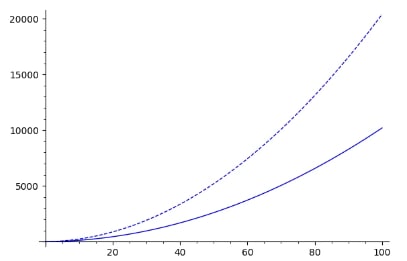2022 | 第十五届全国大学生信息安全竞赛 | 华北赛区 | Crypto
Diophantine
解题思路¶
-
在 PoW 之后有两个判断,枚举一下就可以知道答案
Hello Everyone, let's start to learn Equations! Now I have an elliptic curve equation: (x+1)^2 == 2(y+1)^2 - 3^2 First, tell me if there is a solution to this equation?[Y/N] Y Great! Then, tell me whether this equation has an infinite number of solutions?[Y/N] Y Very well! -
接下来才是重点,需要给出 \(202\) 组解 ΣΣΣ(Φ ωΦ||¡)
Now, please find me the solutions to 202 point{(x, y) where x > 0, y > 0} -
一开始以为是根据
elliptic curve equation: (x+1)^2 == 2(y+1)^2 - 3^2找对应椭圆曲线及其上的点,但是椭圆曲线一般是 \(y^2=x^3+ax+b\) 的形式,\((x+1)^2 == 2(y+1)^2 - 3^2\) 怎么变形都不像 -
后来意识到椭圆曲线方程可能指点的坐标为整数,直接用
z3解方程应该行from z3 import * x, y = Ints('x y') s = Solver() s.add((x + 1) ** 2 == 2 * (y + 1) ** 2 - 9) s.add(x > 0, y > 0) for _ in range(202): s.check() m = s.model() print(f'{m[x]}, {m[y]}') s.add(x > m[x], y > m[y]) -
但是获得了几组解之后,速度就慢下来了 :( 想着画一下曲线图(其实没必要 > <),总之就是两条增长速度不一样的曲线
g1 = plot((x + 1) ** 2, 0, 100) g2 = plot(2 * (x + 1) ** 2 - 9, 0, 100, linestyle="--") (g1 + g2).show()
-
再回过头看看已经获得的解,很有规律的感觉(ŏωŏ)
(2, 2) (20, 14) (122, 86) (716, 506) (4178, 2954) (24356, 17222) -
当 \(i\ge 2\) 时,满足 \(x_i=6\times x_{i-1}-x_{i-2}+4\), \(y_i=6\times y_{i-1}-y_{i-2} + 4\)
from hashlib import md5
import itertools
import pwn
table = 'abcdefghijklmnopqrstuvwxyzABCDEFGHIJKLMNOPQRSTUVWXYZ0123456789'
conn = pwn.remote('39.104.61.18', 12113)
target = conn.recvline_contains('md5').decode().strip()
base = target[target.find('+') + 2:target.find(')')]
target = target[-5:]
for ch in itertools.permutations(table, 4):
m = ''.join(ch) + base
h = md5(m.encode()).hexdigest()
if (h[:5] == target):
conn.sendafter('>', f'{m[:4]}\n')
break
conn.sendafter('equation?[Y/N]', 'Y\n')
conn.sendafter('solutions?[Y/N]', 'Y\n')
ans = [(2, 2), (20, 14)]
while len(ans) < 202:
x, y = (ans[-1][0] * 6 - ans[-2][0] + 4), (ans[-1][1] * 6 - ans[-2][1] + 4)
ans.append((x, y))
for r in ans:
conn.sendafter('x=', f'{r[0]}\n')
conn.sendafter('y=', f'{r[1]}\n')
print(conn.recvline())
conn.interactive()
最后更新:
2022年7月23日 01:05:32
Contributors: